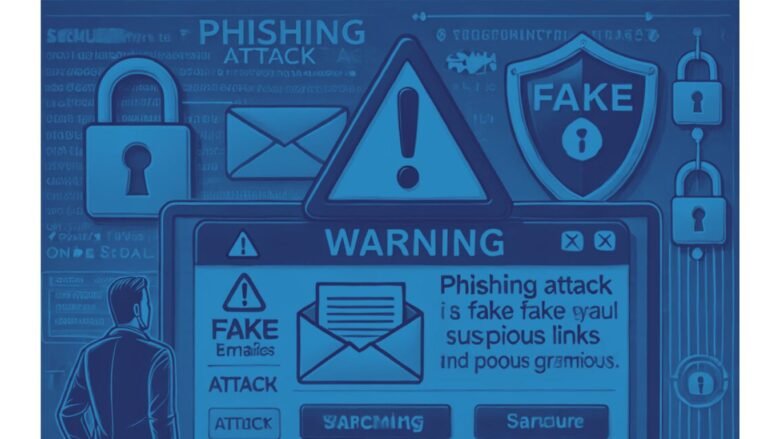- Introduction
Content: Begin by way of introducing phishing attacks. Explain that they may be deceptive attempts to steal touchy records by way of posing as a truthful supply.
- Sample Text:
In nowadays’s digital international, on line scams are greater common than ever, with phishing attacks leading the way. Phishing is a cybercrime in which criminals pose as valid entities to mislead people and attain personal records, inclusive of passwords, credit score card numbers, and financial institution details. Understanding phishing and the way to shield yourself is crucial to staying safe online.- Goal: Briefly define what the web page will cowl: spotting phishing attempts and practical steps to prevent falling victim to these scams.
- Sample Text:
2. What is Phishing?
- Content: Provide a clean and easy definition of phishing. Include specific sorts of phishing assaults.
- Sub-sections:
Definition of Phishing: Explain how phishing involves tricking people into revealing private or financial statistics.- Types of Phishing Attacks: Include diverse sorts, along with:
- Spear Phishing (focused assaults)
- Whaling (aimed toward excessive-profile targets)
- Smishing (SMS phishing)
- Vishing (voice phishing)
- Email Phishing
- Types of Phishing Attacks: Include diverse sorts, along with:
- Sample Text:
Phishing isn’t always limited to at least one technique. Cybercriminals use one of a kind strategies to target users. Email phishing is the maximum common kind, however more state-of-the-art techniques like spear phishing or whaling also are on the upward push.”
3. How to Recognize Phishing Attacks
- Content: Describe the purple flags that imply a phishing strive.
- Sub-sections:
- Suspicious Email Addresses: Look for discrepancies in email addresses and URLs.
- Urgent Language and Threats: Phishing emails frequently create a feel of urgency, the use of terms like “Your account may be closed” or “Immediate movement required.”
- Spelling and Grammar Errors: Phishing emails often include unusual grammar and spelling errors.
- Unfamiliar Greetings and Signatures: Lack of personal touches or overly everyday greetings may be a sign.
- Unexpected Attachments or Links: Phishing emails may consist of dangerous links or attachments.
- Sample Text
Phishing messages regularly sound alarming or create a sense of urgency to spark off short action. You may get hold of an email claiming that your bank account is at hazard or which you need to verify non-public info. If some thing feels off, it in all likelihood is.
4. Examples of Phishing Scams
- Content: Share some real-global examples to illustrate how phishing attacks paintings.
- Sub-sections:
- Fake Bank Notifications
- Social Media Account Lockouts
- Phony Invoice Scams
- Sample Text:
An instance of a phishing rip-off is a faux email from a bank, asking you to confirm your account info. This electronic mail may additionally look actual, whole with the bank’s brand and comparable formatting. However, clicking on any link inside the e-mail could lead you to a faux website designed to thieve your personal statistics.”
5. Consequences of Falling for Phishing Attacks
- Content: Explain the ability impact of phishing assaults on people and organizations.
- Sub-sections:
- Financial Loss
- Identity Theft
- Damage to Personal Reputation
- Potential Business Risks
- Sample Text:
The consequences of a phishing attack may be excessive, ranging from monetary loss and identity robbery to reputational damage and the capacity for agencies to experience facts breaches. Being privy to those outcomes can motivate us to live vigilant.
6. How to Prevent Phishing Attacks
- Content: Provide actionable steps that humans can take to shield themselves.
- Sub-sections:
- Use Multi-Factor Authentication (MFA): Explain how this adds an extra layer of security.
- Be Wary of Links and Attachments: Avoid clicking on unexpected links or downloading attachments from unknown resources.
- Verify Requests for Sensitive Information: Encourage readers to double-take a look at any requests for non-public information by using contacting the organisation without delay.
- Use Antivirus Software: Explain how security software program can assist hit upon phishing tries.
- Educate Yourself and Others: The importance of ongoing cybersecurity education.
- Sample Text:
Phishing assaults are preventable. Simple steps like the usage of multi-element authentication and being cautious of unsolicited emails can go a protracted way in defensive your records. Always double-check requests for sensitive info and by no means proportion passwords through email.
- What to Do if You Suspect a Phishing Attempt
- Content: Outline steps to take while a person suspects they’ve encountered a phishing assault.
- Sub-sections:
- Do Not Respond or Click Links
- Report the Suspicious Email or Message: Include reporting approaches for not unusual systems like Gmail, Outlook, and social media.
- Contact the Relevant Organization: If the phishing strive impersonates a recognised business enterprise, attain out to their customer service.
- Sample Text:
If you come across a suspicious electronic mail or message, do now not respond, click on any hyperlinks, or down load attachments. Instead, document it as phishing to the platform and get in touch with the organization it seems to symbolize.
8. Conclusion
- Content: Reinforce the importance of staying vigilant.
- Sample Text:
Phishing attacks are a actual hazard, but via staying knowledgeable and following simple protection steps, you can significantly reduce your threat. Remember, continually assume earlier than you click on, and don’t share personal statistics with each person you don’t consider.
9. Resources and Further Reading
- Content: List links to additional assets on phishing prevention.
- Examples:
- Cybersecurity web sites
- Online publications on phishing awareness
- Blog posts or publications on phishing detection
10. Call to Action
- Content: Encourage visitors to subscribe to a newsletter, down load a manual on phishing, or take a web quiz on phishing cognizance.
- Sample Text:
Want to stay safe on line? Subscribe to our newsletter for hints on defensive yourself from phishing and different cyber threats, or take our free phishing focus quiz to check your abilties!”




